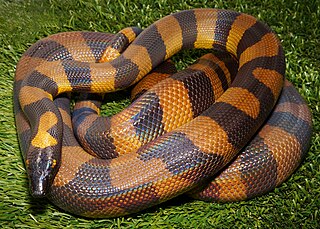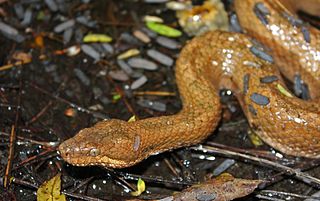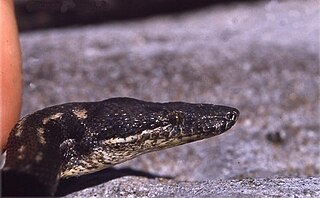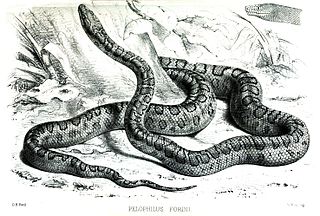
The Boidae, commonly known as boas or boids, are a family of nonvenomous snakes primarily found in the Americas, as well as Africa, Europe, Asia, and some Pacific islands. Boas include some of the world's largest snakes, with the green anaconda of South America being the heaviest and second-longest snake known; in general, adults are medium to large in size, with females usually larger than the males. Six subfamilies comprising 15 genera and 54 species are currently recognized.

Gabriel Bibron was a French zoologist and herpetologist. He was born in Paris. The son of an employee of the Museum national d'histoire naturelle, he had a good foundation in natural history and was hired to collect vertebrates in Italy and Sicily. Under the direction of Jean Baptiste Bory de Saint-Vincent (1778–1846), he took part in the Morea expedition to Peloponnese.

The Bismarck ringed python is a species of snake in the genus Bothrochilus found on the islands of the Bismarck Archipelago. No subspecies are recognized.

Eryx johnii is a species of nonvenomous snake in the subfamily Erycinae of the family Boidae. The species is endemic to Iran, Pakistan, and India. There are no subspecies which are recognized as being valid.

Eryx conicus, also known as Russell's sand boa, the Common sand boa or the rough-tailed sand boa, is a species of non-venomous snake in the subfamily Erycinae of the family Boidae. The species is native to Southern Asia. No subspecies are recognised.

Candoia is a genus of non-venomous boas found mostly in New Guinea, Melanesia and the Maluku Islands in Indonesia. Common names include bevel-nosed boas and keel-scaled boas.

Sanzinia madagascariensis, also known as the Madagascar tree boa or Malagasy tree boa, is a boa species endemic to the island of Madagascar. It was once considered conspecific with the Nosy Komba ground boa. Like all other boas, it is non-venomous.

Acrantophis madagascariensis is a species of boid snake in the subfamily Sanziniinae that is endemic to the island of Madagascar. Its common names include the Madagascar ground boa and Malagasy ground boa.

Tropidophis melanurus, commonly known as the dusky dwarf boa, Cuban wood snake, or Cuban giant dwarf boa, is a nonvenomous dwarf boa species found mainly in Cuba. There are three subspecies that are recognized as being valid, including the nominate subspecies described here.

Tropidophis, common name Caribbean dwarf boas, wood snakes or West Indian wood snakes, is a genus of dwarf boas endemic to the West Indies and South America. Currently, either 17 or 33 species are recognized, depending on the authority.
Tropidophis greenwayi is a nonvenomous dwarf boa species endemic to the Caicos Islands. Two subspecies are currently recognized, including the nominate subspecies described here.

Corallus cookii, also known as Cook's tree boa or Cooke's tree boa, is a species of nonvenomous snake in the family Boidae. The species is endemic to the island of St. Vincent in the Caribbean. There are no recognized subspecies.

The Round Island boa, also known commonly as the Round Island keel-scaled boa and the Round Island ground boa, is a species of nonvenomous snake in the monotypic genus Casarea in the family Bolyeriidae. The species is endemic to Round Island, Mauritius. No subspecies are currently recognized.
Candoia bibroni australis, commonly known as the Solomon Island tree boa, is a boa subspecies endemic to the Solomon Islands. Like all other boas, it is not venomous.

Chilabothrus, commonly known as the Greater Antillean boas or West Indian boas, is a genus of nonvenomous snakes the family Boidae. The genus is endemic to the West Indies. 12 or 14 species are recognized as being valid.

Craspedocephalus brongersmai, also known commonly as Brongersma's pit viper, is a species of venomous snake in the subfamily Crotalinae of the family Viperidae. The species is native to islands off the west coast of Sumatra, Indonesia. No subspecies are currently recognized.

Liasis mackloti, commonly known as Macklot's python or the freckled python, is a species of python, a non-venomous snake in the family Pythonidae. The species is endemic to Indonesia, East Timor, Papua New Guinea, and coastal northern Australia. Three subspecies are recognized, including the nominate subspecies described here.

Candoia carinata, known commonly as the Pacific ground boa, Pacific keel-scaled boa, or Indonesian tree boa, is a species of snake in the family Boidae.

Chilabothrus fordii, also known commonly as Ford's boa and the Haitian ground boa, is a species of snake in the family Boidae. There are three recognized subspecies.
Candoia paulsoni, also known as the Solomon Islands ground boa, is a species of boa native to the Maluku Islands and Melanesia. Five subspecies are recognized.

















